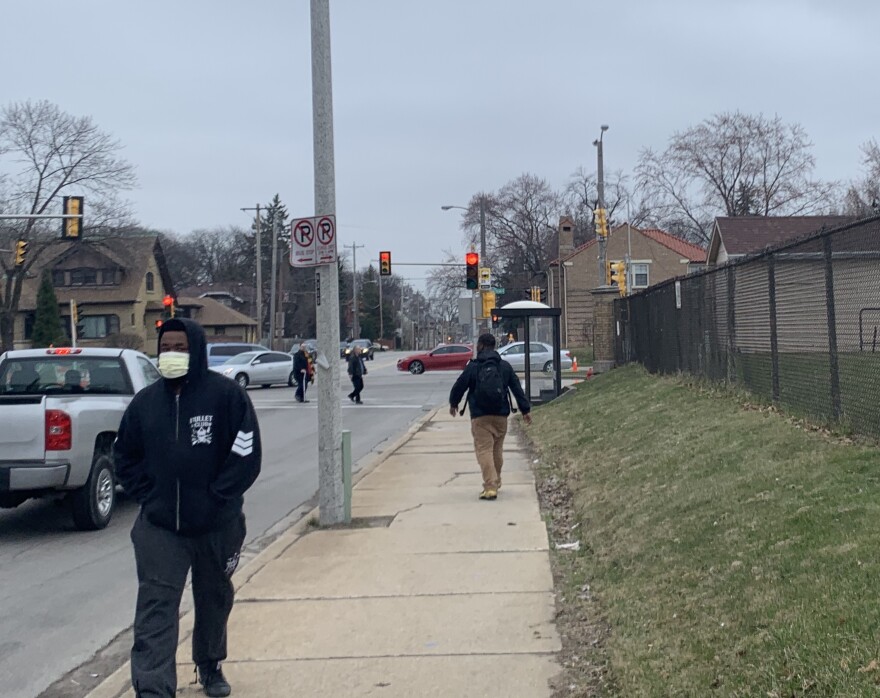Gov. Tony Evers has called COVID-19's impact on Milwaukee’s black community a "crisis within a crisis.”
The majority of coronavirus cases in Milwaukee County are concentrated on the north side of Milwaukee, in predominantly African American neighborhoods. Two other hot spots have been noted in the city, one of which is the 53215 ZIP code — an area with more Latinos than any other ZIP code in Wisconsin.
>>The Latest WUWM & NPR Coronavirus Coverage
>>South Side Milwaukee ZIP Code Has Disproportionate Number Of Cases
>>Coronavirus: Código Postal Del Area Sur De Milwaukee Tiene Un Número Desproporcionado De Casos
Black residents make up about 43% of the people who’ve tested positive for COVID-19 and 62% of those who’ve died, according to the county’s health department. That’s in spite of the fact they comprise 26% of the county’s population.
And the cases are hitting a community impacted by disparities between black people and other groups, including unemployment and access to health care.
Dr. Kevin Izard isn't surprised by the numbers but says they’re still disheartening. Izard is a Milwaukee physician and president of the Cream City Medical Society, an organization that works to eliminate minority health disparities.
"Based on what we know about the virus and who's susceptible, it was predictable that it would be hitting the black community harder than anybody else. And that’s because we tend to have the chronic comorbid diseases that we associate with poor outcomes from being infected," he says. Izard says those are diseases such as high blood pressure and breathing problems, like COPD and asthma.

>>A Deeper Look At The Data: APM Research Lab's The Color Coronavirus
He adds that the coronavirus can spread rapidly where there are higher concentrations of people. He points to outbreaks in big cities like Chicago, Detroit and New Orleans, for example.
Milwaukee is no exception.
"In Milwaukee, the biggest density of people is in the inner city and because of that density you’re going to see more people in close contact with one another — and that allows the virus to spread more easily," Izard says. On top of that, even though the public is being told to socially distance, he says that’s not always possible if multiple family members live in close quarters.
Misinformation around the virus has been an issue as well. Early on, false messages were circulating on social media, claiming that black people could not get the coronavirus.
Joshua Garoon, a professor of community and environmental sociology at UW-Madison, says that misinformation could be contributing to cases on Milwaukee’s north side. He says another factor could be the historic mistrust of the government and health institutions among many black people.
Garoon says, like Izard, he was not shocked by the impact of COVID-19 among Milwaukee's black residents.
"We have, unfortunately, structured our society in the United States around those structural disadvantages that have put black people in these circumstances in which they are just much more susceptible to pandemics like this," Garoon says.
Milwaukee’s Health Commissioner, Jeanette Kowalik, echoes Garoon’s thoughts. She says any type of major event that rocks society is going to create more impact in groups that face other challenges. As cases in low-income communities continue to rise, Kowalik says attention should be paid to safeguarding the health of workers in essential jobs, such as at grocery stores and retail.
"When you look at inequities in pay and gender and race, who’s working in these essential jobs? Who has to work more hours to equal a dollar?" Kowalik says.
Felishia McCall is an essential worker. She has two jobs – one in a Walmart stock room and one at CapTel, a call center for people with hearing impairments.
"I did not get the option to be able to stay home and work from home … and I don’t want to collect unemployment, not to say it like that, but it’s so backed up. I heard it’s like 17 million people that applied in the last three weeks," she says.
McCall says, for the most part, both of her employers are taking precautions. At the call center, when possible, employees leave at least one seat between each other, there is hand sanitizer available and people are wearing masks and gloves. And she says Walmart continues to push best hygiene practices and vigilance of people coming in throughout the day.
She’s just trying to live life as normal as possible. She says having to go to work is stressful, but she continues to pray to make it through.
Support for Race & Ethnicity reporting is provided by the Dohmen Company Foundation.

During this pandemic, WUWM's Bubbler Talk is focusing on the coronavirus and its impact on the Milwaukee area. If you have a question, submit it below.
_




